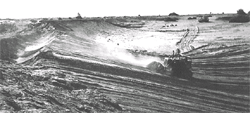Flood for thought
 this is Baluchistan, in Pakistan's west. Infrequent floods, a hot, desert-like climate and an isolated location: Baluchistan's people have adapted themselves well to these disadvantages. They have used flood water irrigation (also called spate irrigation) to make the best of whatever little water nature sends their way. It is rather strange that flood water irrigation, which makes agriculture possible in a region as arid as Baluchistan, is yet to receive the attention it deserves from development officials. Archaeologists, however, have long known the value of harnessing flood waters for irrigating fields. Agriculture fed by floods is an ancient practice going back to 3000 bc when it provided the economic basis for early civilisations in West Asia, the Arab Peninsula and Egypt.
this is Baluchistan, in Pakistan's west. Infrequent floods, a hot, desert-like climate and an isolated location: Baluchistan's people have adapted themselves well to these disadvantages. They have used flood water irrigation (also called spate irrigation) to make the best of whatever little water nature sends their way. It is rather strange that flood water irrigation, which makes agriculture possible in a region as arid as Baluchistan, is yet to receive the attention it deserves from development officials. Archaeologists, however, have long known the value of harnessing flood waters for irrigating fields. Agriculture fed by floods is an ancient practice going back to 3000 bc when it provided the economic basis for early civilisations in West Asia, the Arab Peninsula and Egypt.
Spate irrigation can be of several types. These are spate diversion, where seasonal floodwaters are diverted from the normally-dry riverbeds, inundation canals that start flowing the moment the flood in a perennial river reaches a certain level and flood waters rise, where a rising perennial river overflows its banks and inundates the fields alongside. Baluchistan is familiar with these methods and also with the uncertainty that plagues all floods. And because floods are not really predictable, the risk of crop failure is formidable and the extent of land that farmers can cultivate in a year varies. Therefore, it is natural that the region's cropping practices, farm systems and social structures have been built keeping this uncertainty in mind.
Sailaba , as spate irrigation is known in Baluchistan, is quite different from run-off rainwater harvesting. In sailaba , the catchments are bigger and water is diverted from riverbeds, instead of being collected from hill slopes. In Baluchistan, it is common to find a combination of water harvesting and flood irrigation systems. For instance, in the mountainous regions, the land at the edge may receive water from both the sources. Further, fields are often deliberately kept at a slope so direct rainfall can collect at one edge of the field, making cultivation on a smaller portion of land possible even without floods.
The Sailaba systems vary widely throughout the region, the main parameters being cathcment characteristics, rainfall patter, location, level and so on. All these systems are, however, plagued by a certain uncertainties. These include recurrent uncertainty, related to variations in water availability and those arising out of the systems' configuration. The local people, however, have found ways to mitigate these and maintain agriculture to the best of their abilities. Farmers often save the surplus grains from a peak year, but this is not a common practice, partly due to inadequate storage facilities. Grains are stored either in elevated clay pots or buried and are vulnerable to rodent and pest attacks. A more common method is to buy disposable property that can be sold off in times of crisis. Farmers buy bullocks in a good year and, in the leaner months, live on the money from selling these. Diversification of the household economy is another method of coping with risks. Families generally depend on multiple sources of income, with livestock being a part of the flood irrigated farming system. Small ruminants often boost a family's income to overcome the dry years.
In these dry years, migration becomes increasingly common. In good years, the situation is different and labour demands peak, particularly during land preparation and harvest. This has led to flexible labour markets and, in recent years, mechanised traction. In several parts of Baluchistan, semi-nomadic populations have permanent relations with the flood water cultivators. For instance, the Brahui pastoralists from the hills of central Baluchistan come down to the Kacchi plains in the winters, where they assist in the harvest and and graze their animals. And in some cases, the cultivators themselves leave their flood water-irrigated highland wheat fields after sowing to work on sorghum harvests in the lowlands. They return once the wheat matures.
Another threat to agriculture is depopulation. In regions where farmers depend on each other for reconstructing barrages, the population figures might drop resulting in a freeze in the activities. To solve this crisis, Baloch and Brahui
Related Content
- What does social inclusion mean for a resilient city?: a policy note on urban floods
- Climate change 'will push European cities towards breaking point'
- Adaptation to Climate change project transforms lives of rural communities in Musanze and Nyabihu districts
- Global and regional sea level rise scenarios for the United States
- Man-made warming dates back almost 200 years: study
- Climate 'carbon budget' soon maxed out: Study
